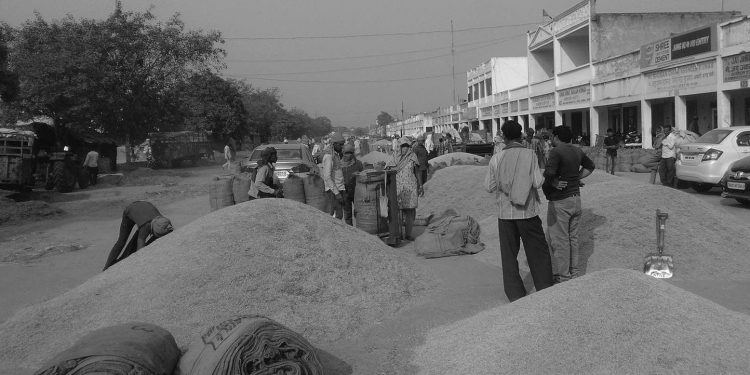Natabar Khuntia
Paddy covers about three-fourths of cultivated area in Odisha; it is the staple of almost the entire population of this state, whose economy is directly linked to production and productivity of paddy. Jeypore in Koraput district is the birthplace of paddy. Odisha is a leading paddy-producing state and since the 1950s has produced it in surplus, except in years when natural calamities have struck.
At present, the state produces 145 lakh tonnes of paddy on average a year and its consumption and seed requirements are met by 105 lakh tonnes. The state has 40 lakh tonnes of marketable surplus. However, that is not the only quantity in the market. Foodgrains at subsidised price under both National Food Security Act and State Food Security Scheme are also in the market. About 3.5 crore persons get 5 kilograms or rice per month at the price of one rupee a kilo. About 22 lakh tonnes of subsidised rice, the equivalent to 33 lakh tonnes of paddy, comes into the market on this count. Besides, another 5 lakh tonnes of rice, that is the equivalent of about 7.5 lakh tonnes of paddy, is required to meet the needs of mid-day meals in schools and in residential schools of tribal students. Therefore, besides marketable surplus of 40 lakh tonnes of paddy, about 40 lakh tonnes of paddy comes to market for sale. The producers, who consume the subsidised rice, want to sell paddy equivalent to the rice they receive.
Food Corporation of India, the central agency procuring grains for the Government of India at minimum support price (MSP) has given the responsibility of paddy procurement to the state civil supplies department. The department, in turn, procures paddy through Primary Agriculture Cooperative Societies (PACS) at the panchayat level.
Buffer stocks can be kept in godowns to meet emergency needs in case of natural calamities. Farmers will also be able to stock up their produce in godowns on payment of rent and against these rent receipts they should be able to avail loans from banks
PACS have no godowns and depend on millers for procurement. They fix dates for the opening of mandis for paddy procurement at MSP from registered farmers. Millers are told to come to the mandis to collect the paddy. PACS works like agents.
Sometimes millers don’t turn up in time and farmers face problems guarding their paddy stocks at mandis. The paddy is not safe from pilferers and the elements at the mandis. Sometimes millers even ask farmers to deliver produce to the mills instead of mandis. Oftentimes the millers in consultation with PACS demand that 5 to 10 kilos be deducted from each quintal of paddy citing that the grain does not meet FAQ (Fair Average Quality) standard prescribed by the government of India. But mandis are not equipped to measure FAQ standards. Farmers allege they are being cheated and are not getting real MSP.
Besides, mandis open for a limited number of days. So farmers have to harvest in a hurry, process and bag the grain and carry these to mandis at short notice. Labour shortage affects these operations and escalates cost of production and reduces profits.
Also, mandis procure grain only from registered farmers with landed property. Share-croppers are not eligible to sell at MSP since they cultivate land based on oral lease. Share-croppers have to sell in the open market at unremunerative prices. The government procures about 50 lakh tonnes of paddy through mandis, whereas marketable surplus is about 80 lakh tonnes. Hence the remaining 30 lakh tonnes are sold in the open market at unremunerative prices ranging from Rs 1,100 to Rs 1,350 per quintal as against the MSP of Rs 1,750. On average a farmer loses Rs 525 per quintal.
So, how can these problems be overcome? On several occasions and pre-budget consultation meetings it is being impressed upon the state government to consider construction of godowns of varying capacities in each panchayat in accordance with the sellable surplus of foodgrains, particularly paddy, at the respective panchayats. Godowns should be given the status of godown-cum-warehouse.
There is no dearth of funds for the constructions of godowns. Credit can be availed from NABARD’s Rural Infrastructure Development Fund (RIDF); also, another fund has been created for financing rural infrastructure such as godowns and cold storages, at liberal terms and conditions.
Labour charges for construction of such facilities can be met from the Mahatma Gandhi National Rural Employment Guarantee Act fund. That would meet 30 per cent of the cost of construction of the godown. The government of India also provides subsidy for rural godowns. It means, there is hardly any resource crunch for construction of godowns. Such facilities should be under the control of panchayats. Also, these local bodies should be authorised to procure paddy and other foodgrains for the civil supplies department and procurement, storing, processing, delivering to public distribution system should be undertaken under the National Food Security Act.
Panchayats should keep paddy procurement at MSP open at least two months from the time of harvest to help farmers sell at ease. Panchayat offices should be equipped with means to measure FAQ standard of paddy instead of arbitrarily determining quality against the interests of farmers.
The government should enact the proposed Land Leasing Act according to the model prepared by the Niti Aayog so that share-croppers can also sell their produce at MSP.
Buffer stocks can be kept in godowns to meet emergency needs in case of natural calamities. Farmers will also be able to stock up their produce in godowns on payment of rent and against these rent receipts they should be able to avail loans from banks.
Unless the government of Odisha takes a long-term view and constructs godowns to handle paddy procurement, offering minimum support price to meet foodgrain requirements under Food Security Act and offers MSP to all categories of farmers, many farmers will continue to sell surplus at unremunerative prices and distress sale will continue.
The writer is an agro-banker and columnist, e-Mail: [email protected].







































